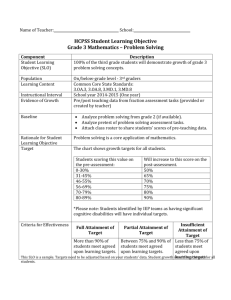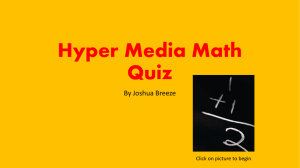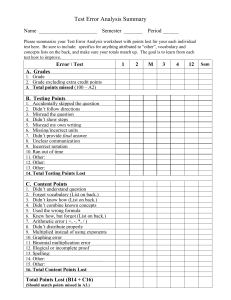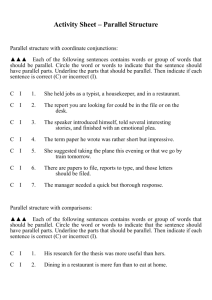Math GR4 SLO-Problem Solving
advertisement
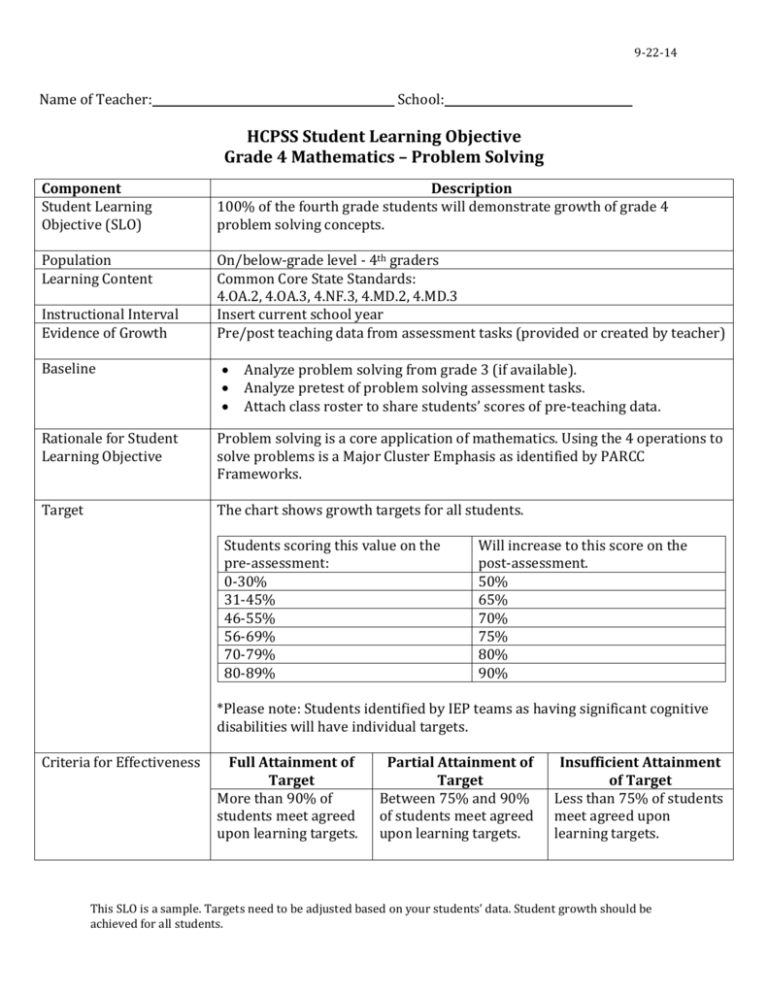
9-22-14 Name of Teacher: School: HCPSS Student Learning Objective Grade 4 Mathematics – Problem Solving Component Student Learning Objective (SLO) Description 100% of the fourth grade students will demonstrate growth of grade 4 problem solving concepts. Population Learning Content On/below-grade level - 4th graders Common Core State Standards: 4.OA.2, 4.OA.3, 4.NF.3, 4.MD.2, 4.MD.3 Insert current school year Pre/post teaching data from assessment tasks (provided or created by teacher) Instructional Interval Evidence of Growth Baseline Rationale for Student Learning Objective Problem solving is a core application of mathematics. Using the 4 operations to solve problems is a Major Cluster Emphasis as identified by PARCC Frameworks. Target The chart shows growth targets for all students. Analyze problem solving from grade 3 (if available). Analyze pretest of problem solving assessment tasks. Attach class roster to share students’ scores of pre-teaching data. Students scoring this value on the pre-assessment: 0-30% 31-45% 46-55% 56-69% 70-79% 80-89% Will increase to this score on the post-assessment. 50% 65% 70% 75% 80% 90% *Please note: Students identified by IEP teams as having significant cognitive disabilities will have individual targets. Criteria for Effectiveness Full Attainment of Target More than 90% of students meet agreed upon learning targets. Partial Attainment of Target Between 75% and 90% of students meet agreed upon learning targets. Insufficient Attainment of Target Less than 75% of students meet agreed upon learning targets. This SLO is a sample. Targets need to be adjusted based on your students’ data. Student growth should be achieved for all students. 9-22-14 Strategies Be purposeful when planning lessons to include challenging mathematical tasks that elicit the Mathematics Practices in their students. Focus on representations for solving problems. Work with all addition/subtraction/multiplication/division problemsolving structures. Focus on problem solving strategies and avoid key word approach Monitor problem solving instructional progress. Apply problem solving to other concepts including measurement, fractions, and area/perimeter. Differentiate instruction and utilize small group instruction. Use multiple means of assessment including observation and paper/pencil assessment. Note: The included assessment can be used to support this SLO. It is optional. Another assessment can be created using assessment tasks aligned to the standards identified in the Learning Content row on the previous page. This SLO is a sample. Targets need to be adjusted based on your students’ data. Student growth should be achieved for all students. Name ______________________________________________ Date _____________________ Grade 4 SLO Problem Solving Assessment 1. Two rectangles each have an area of 48 square inches. Each of them have a different perimeter. Draw a model of each rectangle and give the perimeter of each. 2. A supermarket received a delivery of milk and bread on October 1st. They will then receive a milk delivery every 4 days and a bread delivery every 5 days. On what day of October will the supermarket again have a milk and bread delivery on the same day? Show how you found your answer. The table shows the distances of different trails in a park. 3. Randy hikes two different trails in a weekend. What is the total he might have hiked? Use picutres, numbers, and/or words to explain how you found your answer. Trail Distance (miles) Loop 7 8 Daybreak 7 12 Owl 3 8 Ridge 5 8 Peak 5 12 4. Matt and Manny both have an Xbox. Matt has 6 games for his Xbox and Manny has 42 games. How many times more games does Manny have than Matthew? Use numbers, pictures, or words to explain your answer. The table shows the distances of different trails in a park. Trail Distance (miles) 5. Maria hiked Owl trail 6 times during the summer. How many miles did she hike these 6 times? Loop 7 8 Daybreak 7 12 Owl 3 8 Ridge 5 8 Peak 5 12 Use picutres, numbers, and/or words to explain how you found your answer. 1 6. On Monday, Amy ran 2 kilometers before she needed to take a break. Brittany ran 8 laps 2 on the track, and then she needed to rest. If each lap Brittany ran was 300 meters, who ran a longer distance on Monday: Amy or Brittany? Explain how you know which person ran a longer distance. 7. Rena multiplied two two-digit factors. They had a product between 1,300 and 1,600. What might the factors have been? Explain how you found your solution. 8. Rosa has 18 bags with 6 marbles in each bag. She wants to repackage the marbles with 12 marbles in each bag. How many bags will Rosa need? Explain how you found your solution. 9. The Boy Scouts were planning a breakfast in the school gym. There were 5 round tables and 4 square tables. 6 people can sit at round tables and 4 people can sit at square tables. How many people can sit at all of the tables? Explain how you found your solution. 10. A school was collecting cans for recycling. Fifth grade collected 3,465 cans. Fourth grade collected 4,297 and third grade collected 5,732. How many cans did these grades collect? Explain how you found your solution. 11. Deryn needs ¾ of a foot of yarn for a bracelet. How many feet of yarn does she need for 10 bracelets? Explain how you found your solution. Total points: 25 Scoring Guide: This scoring is recommended to balance the rigor of each item respective to the content on the assessment. It also considers the likelihood of random answers receiving credit. Item 1 Full Value 3 points 2 3 4 5 6 2 points 2 points 2 points 2 points 3 points 7 8 9 10 2 points 2 points 2 points 3 points 11 2 points Partial Value 1 point for 2 different rectangles, 1 point for the perimeter of each rectangle 1 point for incorrect answer with viable strategy 1 point for incorrect answer with viable strategy 1 point for incorrect answer with viable strategy 1 point for incorrect answer with viable strategy 1 point correct conversions, 1 point for correct comparison, 1 point for explanation 1 point for incorrect answer with viable strategy 1 point for incorrect answer with viable strategy 1 point for incorrect answer with viable strategy 2 point for incorrect answer with viable strategy and simple miscalculation, 1 point for incorrect answer and reasonable strategy (with considerable flaw – missing data point, only added 2 data points, etc) 1 point for incorrect answer with viable strategy
